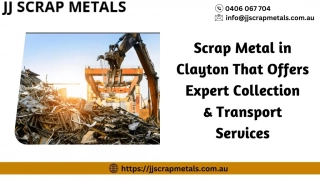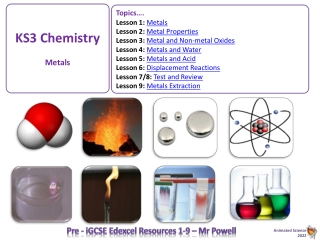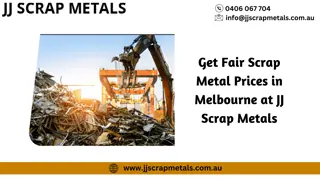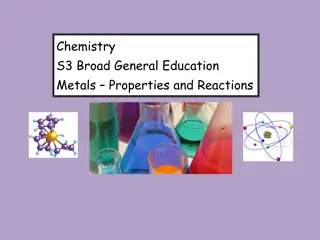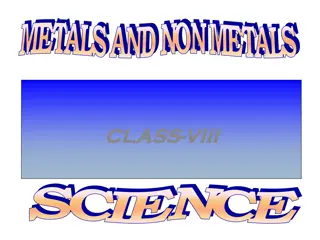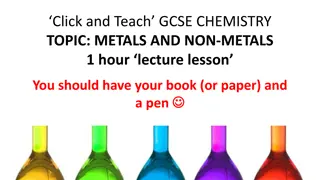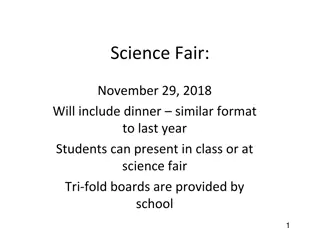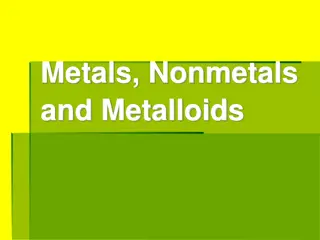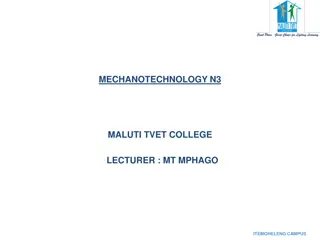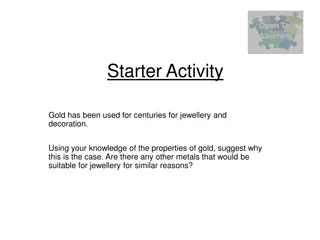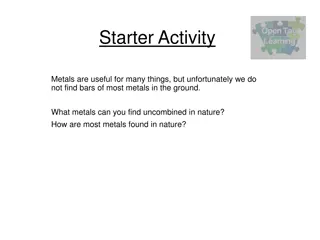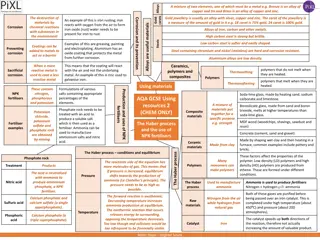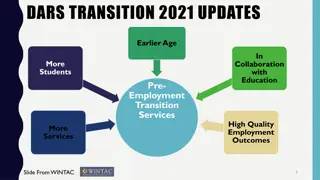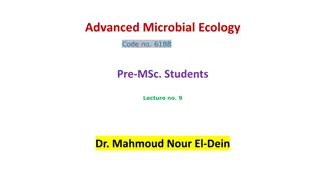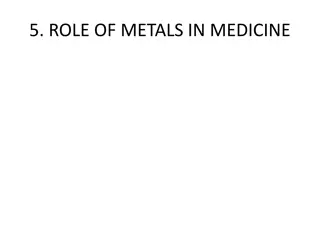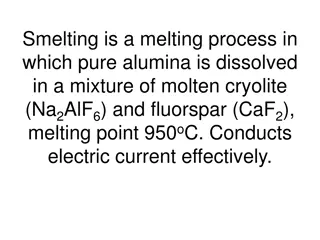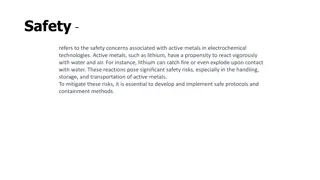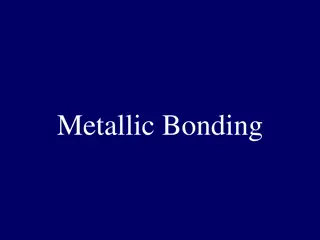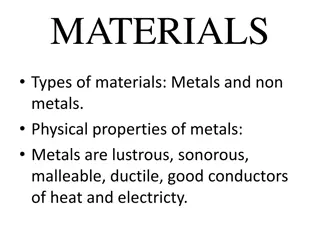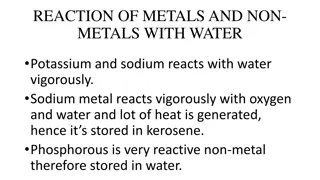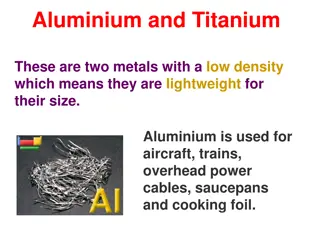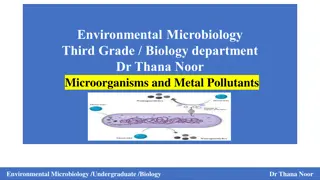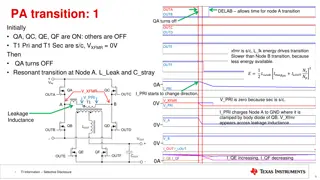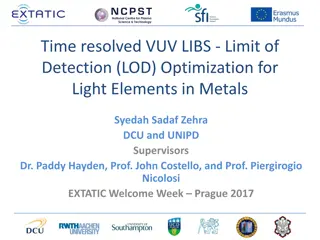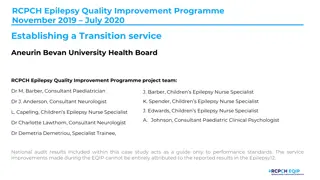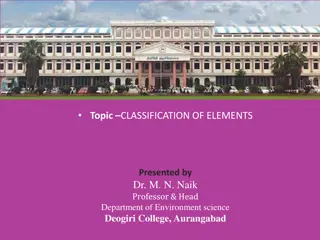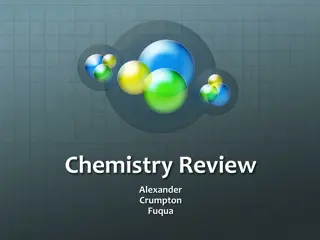Scrap Metal in Clayton That Offers Expert Collection & Transport Services
JJ Scrap Metals, located in Clayton, offers professional scrap metal collection and transportation services. With a team of experts boasting extensive industry knowledge, we assure you of maximising returns for your metals. Our goal is to provide efficient and reliable services, making it convenient
5 views • 4 slides
Understanding Metals: Properties, Reactions & Extraction in Chemistry
Explore the fascinating world of metals through lessons on their properties, reactions with water and acids, displacement reactions, extraction processes, and more. Delve into key terms, such as ions and reactivity series, while discovering how metals interact with various substances. Engage with re
2 views • 77 slides
Understanding Special Education Transition: Goals, Assessments, and Legal Considerations
Exploring the purpose of special education under IDEA 2004, the importance of individualized transition plans, post-secondary goals, the role of transition assessments, and legal implications from case law decisions relating to inadequate transition planning. Key topics include Transition 101, IEP g
7 views • 151 slides
Transition Metals Organometallic Compounds Overview
Transition metals bonded with organometallic compounds like metal alkyls, aryls, and hydrides are common in chemistry. Ligands are crucial for stabilizing these complexes, with carbon-based ligands exhibiting diverse binding modes based on the metal's hybridization state. Preparation methods for tra
1 views • 25 slides
Get Fair Scrap Metal Prices in Melbourne at JJ Scrap Metals
Scrap metal can negatively impact the environment if not managed properly, necessitating careful handling and recycling. \nAt JJ Scrap Metals, we have the expertise to recycle tons of used metals, including copper, aluminium, brass, lead, batteries, iron, wrecked cars, and vehicles. \nAs Melbourne's
1 views • 5 slides
Understanding Metals: Properties, Reactions, and Applications
Metals exhibit unique properties such as conductivity, metallic bonding, and reactivity with acids. They can be combined to form alloys with enhanced characteristics. This overview covers the properties, reactions, and utility of metals in various applications, providing insights into their behavior
1 views • 50 slides
Understanding Metals, Non-Metals, and Their Properties in the Periodic Table
Classification of elements into metals, non-metals, and metalloids based on their properties is essential. Metals are known for their conductivity and malleability, while non-metals have contrasting features like brittleness and poor conductivity. This detailed overview explores the physical propert
0 views • 31 slides
Interactive GCSE Chemistry Lesson on Metals and Non-Metals
Engage in a dynamic one-hour lecture focusing on metals and non-metals in GCSE Chemistry. Discover the properties of metals and non-metals, understand the metallic bond, and explore the periodic table. Participate in tasks of varying difficulty levels, discuss statements related to metals and non-me
0 views • 17 slides
Understanding Complex Ions and Coordinate Bonds in Chemistry
Complex ions in chemistry are formed when transition metals or their ions bond with ligands through coordinate bonds. Ligands utilize their lone pairs of electrons to form dative covalent bonds with transition metals, determining the coordination number of the cation. Complex ions play a crucial rol
1 views • 29 slides
EU Just Transition Fund: Supporting Sustainable Growth and Climate Action
The European Commission's Just Transition Fund aims to support regions facing transition challenges by promoting clean energy, sustainable transport, greener industry, nature protection, and a just transition for all. The fund leverages public financing, provides grants, and crowds in private invest
4 views • 16 slides
Exploring the Conductivity of Metals in Electrical Circuits
This science fair project investigates how different metals affect the amount of current in an electrical circuit. It explores why metals are used to conduct electricity, which metal is the best conductor, and includes a hypothesis based on research findings. The experimental design involves setting
0 views • 15 slides
Understanding Metals, Nonmetals, and Metalloids in the Periodic Table
Explore the characteristics and physical properties of metals, nonmetals, and metalloids. Learn about the differences in appearance, conductive abilities, malleability, ductility, and other key features of these elements. Discover why metals are excellent conductors of heat and electricity, while no
0 views • 18 slides
Understanding Metals: Properties and Heat Treatment Processes
Metals can be categorized into ferrous and non-ferrous based on the presence of iron. Ferrous metals contain iron, while non-ferrous metals do not. Each type has distinct properties like toughness, tensile strength, elasticity, plasticity, ductility, malleability, and hardness. Heat treatment proces
0 views • 9 slides
Understanding the Properties of Metals in Everyday Life
Explore the use of metals in society, focusing on gold's suitability for jewellery due to its unreactive nature, ability to be polished and shaped. Discover terms like lustre, malleable, ductile, and thermal conductivity, essential for understanding metal properties. Engage in activities to define t
0 views • 14 slides
Metal Extraction: Processes and Applications
Metals play a crucial role in various industries, but their extraction from ores is a complex process. Some metals occur naturally in an uncombined form, indicating their low reactivity. Through heat alone, unreactive metals like lead can be separated from their ores. This extraction process involve
2 views • 16 slides
Understanding Alloys and Corrosion in Metals
Alloys are mixtures of elements, with one being a metal, like bronze and brass. Gold jewelry is often alloyed with metals like silver and copper. Corrosion, the deterioration of materials through chemical reactions, can be prevented by using protective coatings. Different types of steels and aluminu
0 views • 4 slides
Understanding Transition Bias and Substitution Models in Genetics
Transition bias and substitution models, explored by Xuhua Xia, delve into the concepts of transitions and transversions in genetic mutations, the causes of transition bias, the ubiquitous nature of transition bias in invertebrate and vertebrate genes, the mitochondrial genetic code, and RNA seconda
0 views • 25 slides
DARS Transition Updates 2021: Enhancing Education & Employment Transition Services
Updates from the Department for Aging and Rehabilitative Services (DARS) highlight improved collaboration with educational institutions, leading to better employment outcomes for youth with disabilities. The data reflects increased participation and services provided across different districts, focu
0 views • 11 slides
Types of Metals and Alloys Used in Construction
Various metals and alloys play crucial roles in construction, from bronze and copper to stainless steel and galvanized steel. Each material has unique properties and applications, such as bronze's malleability, copper's versatility, and stainless steel's resistance to oxidation. Understanding the ch
0 views • 73 slides
Understanding Heavy Metals and Their Impact on Organisms in the Environment
Heavy metals, such as zinc and copper, persist in the environment posing health risks to organisms. Industrial activities release toxic metals into water sources. Microorganisms can interact with heavy metal ions, altering their toxicity and resistance. Essential heavy metals are needed in small amo
0 views • 24 slides
Exploring the Vital Role of Metals in Modern Medicine
An in-depth look at the diverse roles metals play in contemporary medicine, from bio-essential functions to the development of metal-based drugs. Discover how metals like iron, lithium, and auranofin are utilized for medicinal purposes, alongside their applications in non-invasive radiopharmaceutica
0 views • 155 slides
Understanding Coordination Complexes and Transition Metals
Today's lecture covers transition elements, coordination complexes, ligand types, geometries, naming, isomers, and bonding in coordination complexes. Transition metals form coordination complexes with metal ions, ligands, and counter ions. The types of ligands include monodentate and bidentate ligan
0 views • 24 slides
Metal Smelting and Electrorefining Techniques Explained
Smelting is a process involving the dissolution of pure alumina in a molten mixture of cryolite and fluorspar to extract metals like aluminum. Electrolysis is used to separate the metals where oxygen is liberated at the anode and the metal is deposited at the cathode. This process is illustrated wit
0 views • 29 slides
Challenges in Ensuring Critical Mineral Supply for Japan's Sustainable Industrial Activities
Japan faces challenges in securing critical minerals for sustainable industrial activities due to market failures in rare metals trade, lack of information symmetry in supply chains, and the small market size of rare metals. The Government of Japan implements policy measures such as overseas resourc
0 views • 15 slides
Challenges and Impacts of Active Metals in Electrochemical Technologies
Safety concerns arise from the reactivity of active metals like lithium, leading to fire and explosion risks. Economic challenges include high costs and limited availability of these metals. Environmental aspects highlight pollution risks from improper disposal. Images and descriptions illustrate th
0 views • 7 slides
Transition Planning for Community Treatment Programs
Oregon Center of Excellence for Assertive Community Treatment focuses on transition planning to help individuals move from intensive services to less intensive ones. Research shows that only a small percentage of individuals are ready to transition after being served by ACT for years. Topics covered
0 views • 23 slides
Transition from Additional Support: Module 11 Overview & Plan
Module 11 focuses on planning the transition from additional support for learners and families. It covers recognizing when to plan the transition, developing transition plans, celebrating successes, and following up with the learner and family to ensure continued success. The process involves initia
0 views • 8 slides
Enhancing Secondary Transition Services: Key Strategies for Indicator 13 Implementation
Learn about the essential components of Indicator 13 in secondary transition services, including transition assessment, goal-setting, alignment of IEP goals, and coordination for successful student outcomes. Discover why transition assessment is crucial, how it informs the planning process, and the
0 views • 51 slides
Characteristics and Families of the Periodic Table: A Comprehensive Overview
Explore the characteristics of the periodic table including the alkali metals, alkaline earth metals, transition metals, lanthanides, actinides, and more. Learn about the properties, valence electrons, and uses of different groups, such as the boron group, carbon group, nitrogen group, oxygen group,
0 views • 8 slides
Understanding Metallic Bonding and Its Properties
Metallic bonding involves the delocalization of electrons among metal atoms, creating a unique structure known as the electron sea. This structure allows for properties such as high melting points, conductivity of heat and electricity, malleability, and ductility. Metals are able to conduct heat and
0 views • 12 slides
Physical and Chemical Properties of Metals and Non-metals
Metals exhibit physical properties like lustrous appearance, ductility, malleability, and sound production. They are also good conductors of heat and electricity. Non-metals, on the other hand, are brittle, non-sonorous, and poor conductors of heat and electricity. The chemical properties include re
0 views • 13 slides
Reactivity of Metals and Non-Metals: A Comprehensive Overview
Metals like potassium and sodium react vigorously with water, while non-metals like phosphorus are highly reactive and stored in water. Metals react with acids to form hydrogen gas, while non-metals generally do not react with acids. Reactivity series explains displacement reactions where more react
0 views • 11 slides
Lightweight and Corrosion-Resistant Metals: Aluminium and Titanium
Two metals, Aluminium and Titanium, known for their low density and resistance to corrosion, are essential in various industries. Their extraction processes are expensive due to energy requirements and multiple stages involved. Aluminium is extracted from bauxite using the Bayer process, while Titan
0 views • 9 slides
The Role of Microorganisms in Mitigating Heavy Metal Pollution
Metal pollution poses health and ecological risks globally, with heavy metals like mercury and lead causing various harmful conditions. Microorganisms play a crucial role in altering the bioavailability and toxicity of metals. By converting elemental mercury to methylmercury and affecting the valenc
0 views • 9 slides
Understanding Passive/Active Resonant Transition in Power Amplifier
DELAB allows time for node A transition in PA with OUTA and OUTB. The transition is slower than AP transition, making ZVS harder to achieve across load range due to less energy. Transition time is shorter at higher currents, and the controller can adjust delays adaptively. Remember, the conditions f
0 views • 12 slides
Optimizing LOD in Time-Resolved VUV LIBS for Light Elements in Metals
Laser-Induced Breakdown Spectroscopy (LIBS) is a powerful analytical method used to detect elemental composition in various states. This research focuses on optimizing the Limit of Detection (LOD) for Time-Resolved Vacuum Ultraviolet (VUV) LIBS, particularly for light elements in metals. The study a
0 views • 35 slides
Establishing Transition Service for Young Epilepsy Patients at Aneurin Bevan University Health Board
The RCPCH Epilepsy Quality Improvement Programme at Aneurin Bevan University Health Board aimed to improve the transition process for young epilepsy patients. The project team implemented the Ready, Steady, Go model to educate teenagers about managing their condition independently. Changes included
0 views • 15 slides
Understanding the Classification of Elements in the Periodic Table
In 1869, Mendeleev and Lothar Meyer published classification schemes for elements, leading to the development of the Periodic Table. This table organizes elements based on properties and reactivities, with each element having a unique atomic number. There are 92 naturally occurring and 13 man-made e
0 views • 31 slides
Understanding Alkali Metals: Group 1 Elements
Alkali metals, found in Group 1 of the Periodic Table, include elements like lithium, sodium, and potassium. These metals are highly reactive, with properties that change as you move down the group. They have low densities and melting points, and their reactivity increases from top to bottom. Learn
0 views • 12 slides
Chemistry Fundamentals: Elements, Mixtures, Metals, and Changes
Explore fundamental concepts in chemistry including elements found on the periodic table, types of mixtures, characteristics of metals and non-metals, periodic table groups, chemical vs. physical properties, and changes in matter. Learn about the properties and behaviors of elements, compounds, and
0 views • 12 slides
